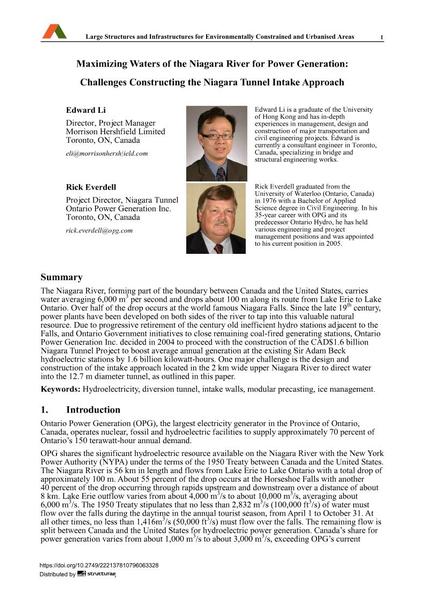Maximizing Waters of the Niagara River for Power Generation: Challenges Constructing the Niagara Tunnel Intake Approach

|
|
|||||||||||
Bibliografische Angaben
| Autor(en): |
Edward Li
Rick Everdell |
||||
|---|---|---|---|---|---|
| Medium: | Tagungsbeitrag | ||||
| Sprache(n): | Englisch | ||||
| Tagung: | IABSE Symposium: Large Structures and Infrastructures for Environmentally Constrained and Urbanised Areas, Venice, Italy, 22-24 September 2010 | ||||
| Veröffentlicht in: | IABSE Symposium Venice 2010 | ||||
|
|||||
| Seite(n): | 690-691 | ||||
| Anzahl der Seiten (im PDF): | 8 | ||||
| Jahr: | 2010 | ||||
| DOI: | 10.2749/222137810796063328 | ||||
| Abstrakt: |
The Niagara River, forming part of the boundary between Canada and the United States, carries water averaging 6,000 m³ per second and drops about 100 m along its route from Lake Erie to Lake Ontario. Over half of the drop occurs at the world famous Niagara Falls. Since the late 19th century, power plants have been developed on both sides of the river to tap into this valuable natural resource. Due to progressive retirement of the century old inefficient hydro stations adjacent to the Falls, and Ontario Government initiatives to close remaining coal-fired generating stations, Ontario Power Generation Inc. decided in 2004 to proceed with the construction of the CAD$1.6 billion Niagara Tunnel Project to boost average annual generation at the existing Sir Adam Beck hydroelectric stations by 1.6 billion kilowatt-hours. One major challenge is the design and construction of the intake approach located in the 2 km wide upper Niagara River to direct water into the 12.7 m diameter tunnel, as outlined in this paper. |
||||
